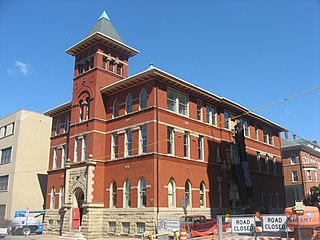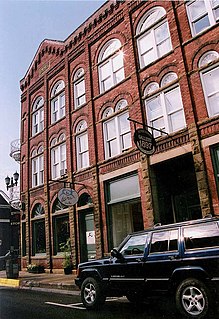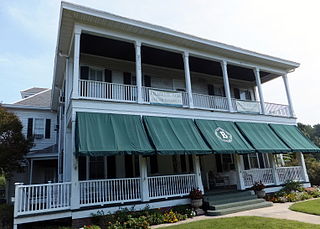
East Bank is a town in Kanawha County, West Virginia, along the Kanawha River. The population was 959 at the 2010 census. East Bank was incorporated in 1889 by special charter enacted by the West Virginia Legislature. It is so named on account off the town's location on the east side of the Kanawha River.

Franklin is a town in Pendleton County, West Virginia, United States. The population was 721 at the 2010 census. It is the county seat of Pendleton County. Franklin was established in 1794 and named for Francis Evick, an early settler.

Cairo is a town in Ritchie County, West Virginia, United States, along West Virginia Route 31, the North Fork of the Hughes River, and the North Bend Rail Trail. The population was 281 at the 2010 census.

Cathedral Parish School, now known as Wheeling Catholic Elementary, was a historic elementary school building located at Wheeling, Ohio County, West Virginia. It was built in 1896–1897, to service the St. Joseph Cathedral parish. A gymnasium addition was built in 1939. It is a three-story brick building, with an elevated first floor. It sits on a sandstone base. It features a center square tower with a pyramidal roof and Late Gothic Revival details.

Literary Hall is a mid-19th-century brick library, building and museum located in Romney, a city in the U.S. state of West Virginia. It is located at the intersection of North High Street and West Main Street. Literary Hall was constructed between 1869 and 1870 by the Romney Literary Society.

The Exchange Building, also known as the Merchant's Exchange Building or The Exchange, is a historic commercial building in at 15-19 West Bank Street in Petersburg, Virginia. Built in 1841, this Greek Revival style building is one of the least-altered examples of a 19th-century market hall. It now houses the Siege Museum commemorating the Siege of Petersburg. It was declared a National Historic Landmark in 1971.

Glen Jean is a census-designated place (CDP) in Fayette County, West Virginia, United States, near Oak Hill. As of the 2010 census, its population is 210.

Kay Moor, also known as Kaymoor, is the site of an abandoned coal mine, coal processing plant and coal town near Fayetteville, West Virginia. The town site is located in the New River Gorge at Kaymoor Bottom (38°03′00″N81°03′17″W). It is linked to the mine portal 560 feet (170 m) above on Sewell Bench (38°02′52″N81°03′58″W) in the wall of the Gorge by conveyors.
Mowbray and Uffinger comprised an architectural partnership in New York City formed in 1895. Known for bank buildings and as vault engineers they designed over 400 banks in the pre-World War II era throughout the country. The principals were Louis Montayne Mowbray (1867-1921) and Justin Maximo Uffinger Sr. (1871-1948).

West Point Historic District is a national historic district located at West Point, King William County, Virginia. The district encompasses 75 contributing buildings and 1 contributing object in the town of West Point. The district includes residential, commercial, and institutional buildings and is notable for its variety of late-19th- and early-20th-century styles and building types. Notable buildings include the William Mitchell House, Anderson-Mayo House, Ware House, St. John's Episcopal Church (1882), Mt. Nebo Baptist Church (1887), West Point United Methodist Church (1889), O'Connor Hotel and annex, Treat-Medlin House (1898), Gouldman House (1923), First Baptist Church (1926), U.S. Post Office (1931), West Point Town Office Building, Citizens and Exchange Bank (1923), and Beverly Allen School (1930s).

Sistersville Historic District is a national historic district located at Sistersville, Tyler County, West Virginia. It encompasses 215 contributing buildings and one contributing structure that include the civic, commercial, and residential core of Sistersville. Most of the buildings in the district date from the late-19th and early-20th century in popular architectural styles, such as Greek Revival, Colonial Revival, and Late Victorian. Notable buildings include the Russell Building or Daily Oil Review Office (1832), McCormick /Henderson House (1880-1884), St. Paul's Episcopal Church (1885), Main Street School (1896), Union National Bank Building, Henneghan-Daly Block (1896), and Riverside Mill (1852). Also located in the district are the separately listed Sistersville City Hall (1897) and Wells Inn (1894).

Lewisburg Historic District is a national historic district located at Lewisburg, Greenbrier County, West Virginia. The district encompasses 112 contributing buildings and are representative of the development and evolution of Lewisburg, over a period of more than two centuries (1763-1977). Notable buildings include log cabins dating to the period 1755–1769, "The Barracks," Mount Esperance (1814), Williams-Henning Store/house (1814-1820), Welch-Bell House (1824), John W. Dunn House, John Withrow's Store/ House (1836), Greenbrier Valley Bank Building (1897), and Carnegie Hall (1902). Located in the district and separately listed are the Old Stone Church, Greenbrier County Courthouse and Lewis Spring, John Wesley Methodist Church, Gov. Samuel Price House, Mt. Tabor Baptist Church, Supreme Court Library Building, James Withrow House, and John A. North House.

Bramwell Historic District is a national historic district located at Bramwell, Mercer County, West Virginia. The district includes 65 contributing buildings and 2 contributing structures in the central business district and surrounding residential areas of Bramwell. Most of the buildings pre-date the 1920s. Notable buildings include the Bramwell Town Hall, Bryant Building, Masonic Hall, Cooper House (1910), Cooper Indoor Pool (1910), Cooper Garage Apartment (1910), Bank of Bramwell, Perry House, Hewitt House (1914-1915), Hewitt Garage Apartment (1914-1915), Mann House, Bramwell Presbyterian Church (1902), Goodwill House, Thomas House, Thomas Garage / Apartment, Buck/Bowen House, Mann Playhouse, Freeman House, and Former Holy Trinity Episcopal Church.

Shaw Hall is a historic dormitory located on the campus of West Liberty University at West Liberty, Ohio County, West Virginia. It was built in 1919–1920, and is a three-story red brick building in the Classical Revival style. The front and end facades are dominated by two-story porticos with Ionic order columns having a stucco shaft. It was built as the first dormitory on campus and housed female students. It is the oldest building on the campus of West Liberty University. The building now houses classrooms and administrative offices. The building is named for John C. Shaw, president of West Liberty Normal School from 1908 to 1919.

Shotwell Hall, also known as Fraternity Hall, is a historic dormitory located on the campus of West Liberty University at West Liberty, Ohio County, West Virginia. It was designed by noted Wheeling architect Frederick F. Faris (1870-1927) and built as a Public Works Administration project in 1937. It is a 2 1⁄2-story red brick over concrete block building in the Colonial Revival style. It features a broken pediment doorway and pedimented gable ends. The building was built as a men's dormitory, but now houses faculty offices. The building is named for Nathan Shotwell, first president of West Liberty Academy from 1838 to 1854.

Wheeling Historic District, also known as the Wheeling Central Business District, is a national historic district located at Wheeling, Ohio County, West Virginia. The district includes 205 contributing buildings in the central business district of Wheeling. It includes the site of the original location of Fort Henry. The buildings are representative of a number of popular architectural styles from the early-19th century through the present including Greek Revival and Late Victorian. The District was listed on the National Register of Historic Places in 1979.

The Wirgman Building was an early 19th-century Federal-style commercial and residential building located on East Main Street in Romney, West Virginia. It was completed around 1825 to serve as the Romney branch office of the Bank of the Valley of Virginia, and served as a location for every subsequent bank established in Romney, including the Bank of Romney and the First National Bank of Romney. During the American Civil War, the building was used as a military prison. For a time, its second floor housed the offices and printing plant of the Hampshire Review newspaper, and by 1947 its ground floor housed office and mercantile space, and the second floor was divided into apartments.

Mineral Historic District is a national historic district located at Mineral, Louisa County, Virginia. It encompasses 222 contributing buildings, 3 contributing sites, and 6 contributing structures in the town of Mineral. It includes a variety of residential, commercial, and institutional buildings built after the town was platted in 1890. Notable buildings include the Gibson House (1915), Turner House, Dr. H. J. Judd House (1906), Odd Fellows Hall (1894), former D.E. Bumpass Department Store, former Mineral Drug Store, Bank of Louisa, C&O railroad depot (1880s), Mineral Crystal Ice Plant, Louisa County Power & Light Plant, Standard Oil Company building (1907), Episcopal Church of Incarnation (1902-1903), Mineral Baptist Church (1906), and the former Mineral School (1927).

Simon Reid Curtis House, now known as the Boxwood Inn, is a historic home located in the Lee Hall neighborhood of Newport News, Virginia. It was built in 1897, and is a large, 2 1/2-story, Colonial Revival style frame combined store, post office, and dwelling. The building consists of two separate structures attached to form a "T" shaped building with common architectural features. It was built by Simon Reid Curtis (1862–1949), a prominent businessman and land owner, who was an influential political leader in Warwick County, Virginia from the 1890s until his death in 1949. The Curtis family owned the house until 1996 when it was sold, renovated, and converted into a bed and breakfast.




















